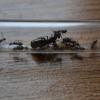- Formiculture.com
- Forums
- Gallery
- Members
- Member Map
- Chat

My pheidole are producing majors in the second generation! Why?
Started By
Aidanthielman
, Oct 24 2019 3:43 PM
10 replies to this topic
#1
 Offline
-
Posted October 24 2019 - 3:43 PM
Offline
-
Posted October 24 2019 - 3:43 PM
My pheidole hyatti are producing soldiers in their second generation. I’ve heard they develop when the ants feel threatened or at being disturbed to much, but I don’t disturb them much only to feed them or when I check on them every now and then. I’m just confused, if you have an answer or a theory let me know why it is!
Btw not complaining because I love majors just wondering why😄
Btw not complaining because I love majors just wondering why😄
#2
 Offline
-
Posted October 24 2019 - 3:50 PM
Offline
-
Posted October 24 2019 - 3:50 PM
Pheidole just develop quickly. My Pheidole bicarinata colony has 100 workers and 15 majors.
My Main Journal | My Neivamyrmex Journal | My Ant Adoption | My YouTube
Join the TennesseeAnts Discord Server! https://discord.gg/JbKwPgs
#3
 Offline
-
Posted October 24 2019 - 4:01 PM
Offline
-
Posted October 24 2019 - 4:01 PM
Ok so I do t have to worry I’m bothering them to much 
#4
 Offline
-
Posted October 24 2019 - 4:11 PM
Offline
-
Posted October 24 2019 - 4:11 PM
yeah, they grow quickly. some have majors in their first gen
#5
 Offline
-
Posted October 25 2019 - 5:30 AM
Offline
-
Posted October 25 2019 - 5:30 AM
Ok so I do t have to worry I’m bothering them to much
It also depends on the amount of protein consumption
There is a important time for everything, important place for everyone, an important person for everybody, and an important ant for each and every ant keeper and myrmecologist alike
#6
 Offline
-
Posted October 25 2019 - 6:04 AM
Offline
-
Posted October 25 2019 - 6:04 AM
Ohh that makes sense I feed them a lot of mealworms. It seems to be their favorite meal, along with cut up apples.
#7
 Offline
-
Posted October 25 2019 - 7:56 AM
Offline
-
Posted October 25 2019 - 7:56 AM
Because they are Pheidole and that's what they do.
#8
 Offline
-
Posted October 25 2019 - 12:13 PM
Offline
-
Posted October 25 2019 - 12:13 PM
yeah, because of the size differences, and their fast growing nature, they are protein behemothsBecause they are Pheidole and that's what they do.
- TennesseeAnts likes this
There is a important time for everything, important place for everyone, an important person for everybody, and an important ant for each and every ant keeper and myrmecologist alike
#9
 Offline
-
Posted October 25 2019 - 3:37 PM
Offline
-
Posted October 25 2019 - 3:37 PM
I think that in the ant keeping community we over-play the effects that environmental conditions have on Pheidole spp. major production. I know in the case of Pheidole bicarinata it is very heavily tied in with how many other majors are present in the nest, how big those majors are, etc. Obviously food intake also plays a role in major production.
The only scientific paper I found that looked at a change in major production, focused on how Solenopsis invicta attacks on the ant Pheidole dentata changed the composition of worker castes in the colony. It didn't change it at all. Even with a high need for defense, a task very commonly assigned to majors in the genus Pheidole, no more majors were produced than if the colony hadn't been attacked.
If anyone finds a mistake, something I'm missing, or something to add, please, speak up. Whenever I do posts like these on the forum my goal is to simply look at a question, break it down, then see what the most scientifically-supported answer is.
- TennesseeAnts, ANTdrew, Somethinghmm and 1 other like this
Currently Keeping:
Trachymyrmex septentrionalis
Pheidole pilifera
Forelius sp. (Monogynous, bicolored) "Midwestern Forelius"
Crematogaster cerasi
Pheidole bicarinata
Aphaenogaster rudis
Camponotus chromaiodes
Formica sp. (microgena species)
Nylanderia cf. arenivega
#10
 Offline
-
Posted October 26 2019 - 5:04 AM
Offline
-
Posted October 26 2019 - 5:04 AM
Maybe the protein consumption stayed the same and thus, couldn't produce more majorsI think that in the ant keeping community we over-play the effects that environmental conditions have on Pheidole spp. major production. I know in the case of Pheidole bicarinata it is very heavily tied in with how many other majors are present in the nest, how big those majors are, etc. Obviously food intake also plays a role in major production.
The only scientific paper I found that looked at a change in major production, focused on how Solenopsis invicta attacks on the ant Pheidole dentata changed the composition of worker castes in the colony. It didn't change it at all. Even with a high need for defense, a task very commonly assigned to majors in the genus Pheidole, no more majors were produced than if the colony hadn't been attacked.
If anyone finds a mistake, something I'm missing, or something to add, please, speak up. Whenever I do posts like these on the forum my goal is to simply look at a question, break it down, then see what the most scientifically-supported answer is.
There is a important time for everything, important place for everyone, an important person for everybody, and an important ant for each and every ant keeper and myrmecologist alike
#11
 Offline
-
Posted October 27 2019 - 5:33 PM
Offline
-
Posted October 27 2019 - 5:33 PM
Maybe the protein consumption stayed the same and thus, couldn't produce more majorsI think that in the ant keeping community we over-play the effects that environmental conditions have on Pheidole spp. major production. I know in the case of Pheidole bicarinata it is very heavily tied in with how many other majors are present in the nest, how big those majors are, etc. Obviously food intake also plays a role in major production.
The only scientific paper I found that looked at a change in major production, focused on how Solenopsis invicta attacks on the ant Pheidole dentata changed the composition of worker castes in the colony. It didn't change it at all. Even with a high need for defense, a task very commonly assigned to majors in the genus Pheidole, no more majors were produced than if the colony hadn't been attacked.
If anyone finds a mistake, something I'm missing, or something to add, please, speak up. Whenever I do posts like these on the forum my goal is to simply look at a question, break it down, then see what the most scientifically-supported answer is.
This was a mature colony that they studied. More than 3,000 workers. If majors were more advantageous than minors, more would of been produced. Wild colonies make sacrifices like this all the time. The same study also stated that during the reproductive season, when mature colonies are producing alates, they produced far fewer majors.
- Canadian anter and DDD101DDD like this
Currently Keeping:
Trachymyrmex septentrionalis
Pheidole pilifera
Forelius sp. (Monogynous, bicolored) "Midwestern Forelius"
Crematogaster cerasi
Pheidole bicarinata
Aphaenogaster rudis
Camponotus chromaiodes
Formica sp. (microgena species)
Nylanderia cf. arenivega
1 user(s) are reading this topic
0 members, 1 guests, 0 anonymous users

















